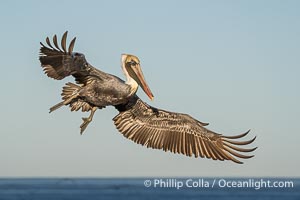
A California Brown Pelican flying over the Pacific Ocean, spreads its large wings wide to slow down as it banks, turns in midair, to land on seacliffs in La Jolla. Winter adult non-breeding plumage.
Species: Brown Pelican, Pelecanus occidentalis californicus, Pelecanus occidentalis
Location: La Jolla, California
Image ID: 39789
Species: Brown Pelican, Pelecanus occidentalis californicus, Pelecanus occidentalis
Location: La Jolla, California
Image ID: 39789

Brown pelican in flight with wings spread wide, slowing as it returns from the ocean to land on seacliffs, adult winter non-breeding plumage.
Species: Brown Pelican, Pelecanus occidentalis, Pelecanus occidentalis californicus
Location: La Jolla, California
Image ID: 38584
Species: Brown Pelican, Pelecanus occidentalis, Pelecanus occidentalis californicus
Location: La Jolla, California
Image ID: 38584
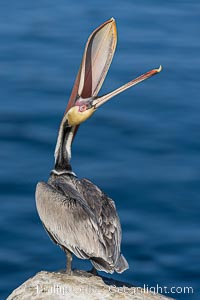
Spectacular Brown Pelican Head Throw Display. This California brown pelican is arching its head and neck way back, opening its mouth in a behavior known as a head throw or bill throw.
Species: Brown Pelican, Pelecanus occidentalis, Pelecanus occidentalis californicus
Location: La Jolla, California
Image ID: 38675
Species: Brown Pelican, Pelecanus occidentalis, Pelecanus occidentalis californicus
Location: La Jolla, California
Image ID: 38675
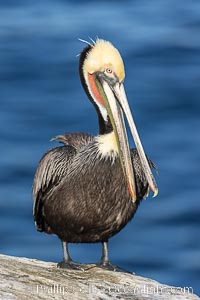
California brown pelican winter breeding plumage portrait, this adult is gently clapping its jaws, showing brown hind neck with yellow head, red and olive throat pouch, white with yellow chevron on the breast.
Species: Brown Pelican, Pelecanus occidentalis, Pelecanus occidentalis californicus
Location: La Jolla, California
Image ID: 38692
Species: Brown Pelican, Pelecanus occidentalis, Pelecanus occidentalis californicus
Location: La Jolla, California
Image ID: 38692
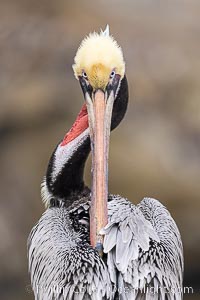
California Brown Pelican Portrait With Twisted Neck, overcast light, winter adult breeding plumage, head twisted to face backwards as it preens, eyes locked on camera.
Species: Brown Pelican, Pelecanus occidentalis, Pelecanus occidentalis californicus
Location: La Jolla, California
Image ID: 38861
Species: Brown Pelican, Pelecanus occidentalis, Pelecanus occidentalis californicus
Location: La Jolla, California
Image ID: 38861
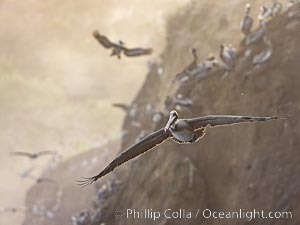
Brown Pelicans Flying Along Sheer Ocean Cliffs, rare westerly winds associated with a storm allow pelicans to glide along La Jolla's cliffs as they approach shelves and outcroppings on which to land. Backlit by rising sun during stormy conditions.
Species: Brown Pelican, Pelecanus occidentalis, Pelecanus occidentalis californicus
Location: La Jolla, California
Image ID: 38867
Species: Brown Pelican, Pelecanus occidentalis, Pelecanus occidentalis californicus
Location: La Jolla, California
Image ID: 38867
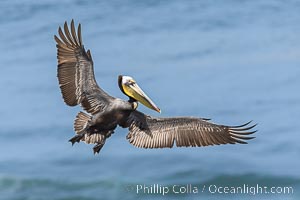
California Brown pelican in flight, La Jolla, wings outstretched, spreading wings wide to slow in anticipation of landing on seacliffs. Adult winter breeding plumage colors.
Species: Brown Pelican, Pelecanus occidentalis, Pelecanus occidentalis californicus
Location: La Jolla, California
Image ID: 38884
Species: Brown Pelican, Pelecanus occidentalis, Pelecanus occidentalis californicus
Location: La Jolla, California
Image ID: 38884
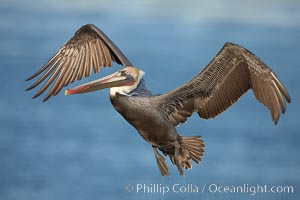
Brown pelican in flight. The wingspan of the brown pelican is over 7 feet wide. The California race of the brown pelican holds endangered species status. Adult winter non-breeding plumage.
Species: Brown Pelican, Pelecanus occidentalis, Pelecanus occidentalis californicus
Location: La Jolla, California
Image ID: 22142
Species: Brown Pelican, Pelecanus occidentalis, Pelecanus occidentalis californicus
Location: La Jolla, California
Image ID: 22142
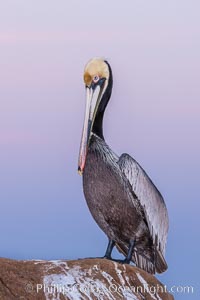
California brown pelican, portrait in pink-purple predawn light, rests on sandstone seabluff. The characteristic breeding plumage of the California race of brown pelican is shown, with red gular throat pouch and dark brown hindneck colors.
Species: Brown Pelican, Pelecanus occidentalis, Pelecanus occidentalis californicus
Location: La Jolla, California
Image ID: 23646
Species: Brown Pelican, Pelecanus occidentalis, Pelecanus occidentalis californicus
Location: La Jolla, California
Image ID: 23646
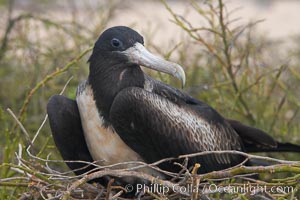
Magnificent frigatebird, adult female on nest.
Species: Magnificent frigatebird, Fregata magnificens
Location: North Seymour Island, Galapagos Islands, Ecuador
Image ID: 16726
Species: Magnificent frigatebird, Fregata magnificens
Location: North Seymour Island, Galapagos Islands, Ecuador
Image ID: 16726
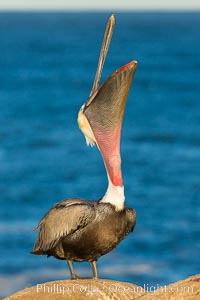
California Brown Pelican head throw, stretching its throat to keep it flexible and healthy. Adult winter non-breeding plumage.
Species: Brown Pelican, Pelecanus occidentalis, Pelecanus occidentalis californicus
Location: La Jolla, California
Image ID: 28347
Species: Brown Pelican, Pelecanus occidentalis, Pelecanus occidentalis californicus
Location: La Jolla, California
Image ID: 28347
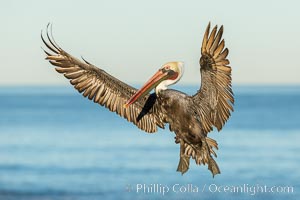
Brown pelican in flight. The wingspan of the brown pelican is over 7 feet wide. The California race of the brown pelican holds endangered species status. Adult winter non-breeding plumage.
Species: Brown Pelican, Pelecanus occidentalis, Pelecanus occidentalis californicus
Location: La Jolla, California
Image ID: 28356
Species: Brown Pelican, Pelecanus occidentalis, Pelecanus occidentalis californicus
Location: La Jolla, California
Image ID: 28356
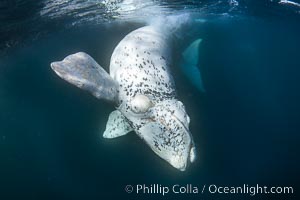
White southern right whale calf underwater, Eubalaena australis. About five per cent of southern right whales are born white due to a condition known as grey morphism and will gradually turn dark as they age. They are not albino (which is a complete lack of pigmentation). Sometimes referred to as "brindled", the white coloration is a recessive genetic trait and only lasts a few months. Typically, but not always, white calves will become much darker as they mature but will still be somewhat lighter than normal even as adults.
Species: Southern Right Whale, Eubalaena australis
Location: Puerto Piramides, Chubut, Argentina
Image ID: 38279
Species: Southern Right Whale, Eubalaena australis
Location: Puerto Piramides, Chubut, Argentina
Image ID: 38279

Acorn Woodpecker Adult Feeding Chick at the Nest, Lake Hodges.
Location: Lake Hodges, San Diego, California
Image ID: 39395
Location: Lake Hodges, San Diego, California
Image ID: 39395
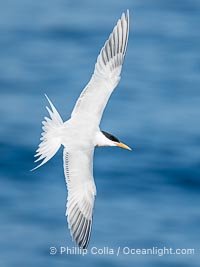
Royal Tern in flight, adult breeding plumage with black head cap, La Jolla.
Species: Royal tern, Sterna maxima, Thalasseus maximus
Location: La Jolla, California
Image ID: 41002
Species: Royal tern, Sterna maxima, Thalasseus maximus
Location: La Jolla, California
Image ID: 41002

Brown pelican in flight with wings spread wide, slowing as it returns from the ocean to land on seacliffs, adult winter non-breeding plumage.
Species: Brown Pelican, Pelecanus occidentalis, Pelecanus occidentalis californicus
Location: La Jolla, California
Image ID: 38608
Species: Brown Pelican, Pelecanus occidentalis, Pelecanus occidentalis californicus
Location: La Jolla, California
Image ID: 38608
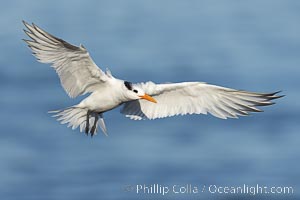
Royal Tern in flight, adult non-breeding plumage, La Jolla.
Species: Royal tern, Sterna maxima, Thalasseus maximus
Location: La Jolla, California
Image ID: 38669
Species: Royal tern, Sterna maxima, Thalasseus maximus
Location: La Jolla, California
Image ID: 38669
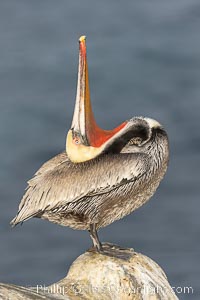
Pelican yoga, Utthita Tadasana, extended mountain pose with backbend. A California brown pelican preening, rubbing the back of its head and neck on the uropygial gland (preen gland) near the base of its tail. Preen oil from the uropygial gland is spread by the pelican's beak and back of its head to all other feathers on the pelican, helping to keep them water resistant and dry. Adult winter breeding plumage showing brown hindneck and red gular throat pouch.
Species: Brown Pelican, Pelecanus occidentalis, Pelecanus occidentalis californicus
Location: La Jolla, California
Image ID: 38710
Species: Brown Pelican, Pelecanus occidentalis, Pelecanus occidentalis californicus
Location: La Jolla, California
Image ID: 38710
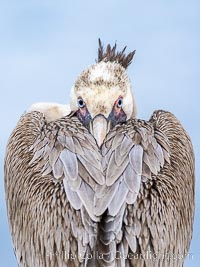
California Brown Pelican Portrait, immature with head tucked into feathers, resting and staring at the camera, overcast light, immature/juvenile plumage.
Species: Brown Pelican, Pelecanus occidentalis, Pelecanus occidentalis californicus
Location: La Jolla, California
Image ID: 38862
Species: Brown Pelican, Pelecanus occidentalis, Pelecanus occidentalis californicus
Location: La Jolla, California
Image ID: 38862
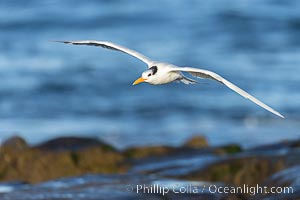
Royal Tern in flight, adult non-breeding plumage, La Jolla.
Species: Royal tern, Sterna maxima, Thalasseus maximus
Location: La Jolla, California
Image ID: 38952
Species: Royal tern, Sterna maxima, Thalasseus maximus
Location: La Jolla, California
Image ID: 38952

Yellow morph of the California brown pelican in flight. The wingspan of the brown pelican is over 7 feet wide. The California race of the brown pelican holds endangered species status. In winter months, breeding adults assume a dramatic plumage.
Species: Brown Pelican, Pelecanus occidentalis, Pelecanus occidentalis californicus
Location: La Jolla, California
Image ID: 15371
Species: Brown Pelican, Pelecanus occidentalis, Pelecanus occidentalis californicus
Location: La Jolla, California
Image ID: 15371
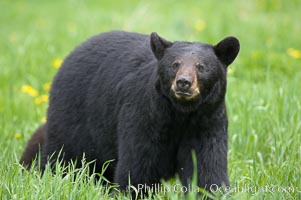
Black bear walking in a grassy meadow. Black bears can live 25 years or more, and range in color from deepest black to chocolate and cinnamon brown. Adult males typically weigh up to 600 pounds. Adult females weight up to 400 pounds and reach sexual maturity at 3 or 4 years of age. Adults stand about 3' tall at the shoulder.
Species: American black bear, Ursus americanus
Location: Orr, Minnesota
Image ID: 18744
Species: American black bear, Ursus americanus
Location: Orr, Minnesota
Image ID: 18744
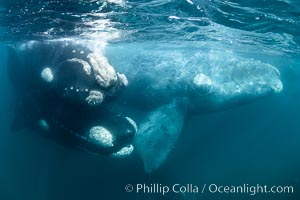
Mating pair of southern right whales underwater (on left). The gray adult whale on the right was formerly a white calf and, while it is not longer white, will remain lighter than normal throughout its life, Eubalaena australis, Argentina.
Species: Southern Right Whale, Eubalaena australis
Location: Puerto Piramides, Chubut, Argentina
Image ID: 35923
Species: Southern Right Whale, Eubalaena australis
Location: Puerto Piramides, Chubut, Argentina
Image ID: 35923
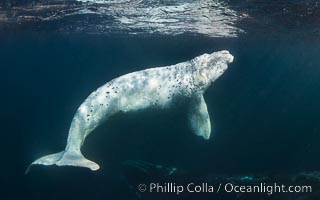
White southern right whale calf underwater, Eubalaena australis. About five per cent of southern right whales are born white due to a condition known as grey morphism and will gradually turn dark as they age. They are not albino (which is a complete lack of pigmentation). Sometimes referred to as "brindled", the white coloration is a recessive genetic trait and only lasts a few months. Typically, but not always, white calves will become much darker as they mature but will still be somewhat lighter than normal even as adults.
Species: Southern Right Whale, Eubalaena australis
Location: Puerto Piramides, Chubut, Argentina
Image ID: 38261
Species: Southern Right Whale, Eubalaena australis
Location: Puerto Piramides, Chubut, Argentina
Image ID: 38261
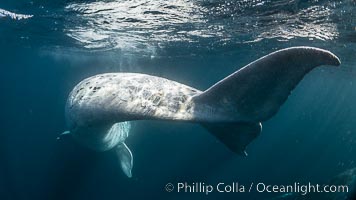
White southern right whale calf underwater, Eubalaena australis. About five per cent of southern right whales are born white due to a condition known as grey morphism and will gradually turn dark as they age. They are not albino (which is a complete lack of pigmentation). Sometimes referred to as "brindled", the white coloration is a recessive genetic trait and only lasts a few months. Typically, but not always, white calves will become much darker as they mature but will still be somewhat lighter than normal even as adults.
Species: Southern Right Whale, Eubalaena australis
Location: Puerto Piramides, Chubut, Argentina
Image ID: 38434
Species: Southern Right Whale, Eubalaena australis
Location: Puerto Piramides, Chubut, Argentina
Image ID: 38434
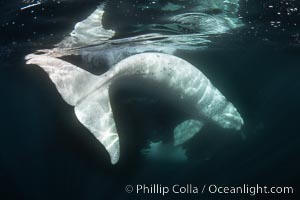
White southern right whale calf underwater, Eubalaena australis. About five per cent of southern right whales are born white due to a condition known as grey morphism and will gradually turn dark as they age. They are not albino (which is a complete lack of pigmentation). Sometimes referred to as "brindled", the white coloration is a recessive genetic trait and only lasts a few months. Typically, but not always, white calves will become much darker as they mature but will still be somewhat lighter than normal even as adults.
Species: Southern Right Whale, Eubalaena australis
Location: Puerto Piramides, Chubut, Argentina
Image ID: 38438
Species: Southern Right Whale, Eubalaena australis
Location: Puerto Piramides, Chubut, Argentina
Image ID: 38438
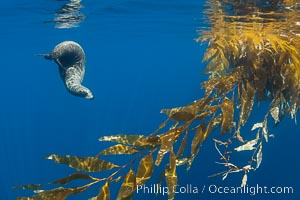
California sea lion resting alongside a drift kelp paddy, underwater. This adult female California sea lion was hanging out underneath a paddy of drift kelp, well offshore the coastline of San Diego.
Species: California sea lion, Zalophus californianus
Location: San Diego, California
Image ID: 38535
Species: California sea lion, Zalophus californianus
Location: San Diego, California
Image ID: 38535
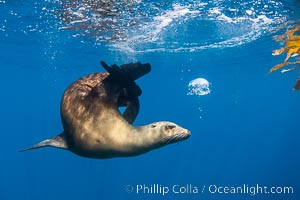
California sea lion on drift kelp paddy, underwater. This adult female California sea lion was hanging out underneath a paddy of drift kelp, well offshore the coastline of San Diego.
Species: California sea lion, Zalophus californianus
Location: San Diego, California
Image ID: 38540
Species: California sea lion, Zalophus californianus
Location: San Diego, California
Image ID: 38540
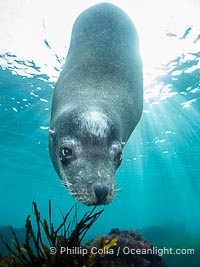
Huge California Sea Lion Male Underwater, a bull, patrolling his breeding harem and territory, Coronado Islands, Mexico. His sagittal crest, the bony bump on his head that distinguishes adult male sea lions, is clearly seen. This particular sea lion bears an orange tag on his left foreflipper, probably as a result of rescue and release as a young sea lion years earlier.
Species: California sea lion, Zalophus californianus
Location: Coronado Islands (Islas Coronado), Baja California, Mexico
Image ID: 38657
Species: California sea lion, Zalophus californianus
Location: Coronado Islands (Islas Coronado), Baja California, Mexico
Image ID: 38657
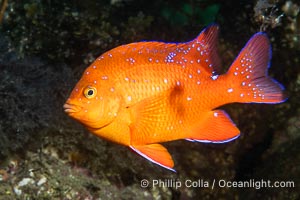
Juvenile garibaldi, vibrant spots distinguish it from pure orange adult form.
Species: Garibaldi, Hypsypops rubicundus
Location: Catalina Island, California
Image ID: 40527
Species: Garibaldi, Hypsypops rubicundus
Location: Catalina Island, California
Image ID: 40527